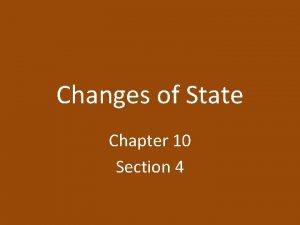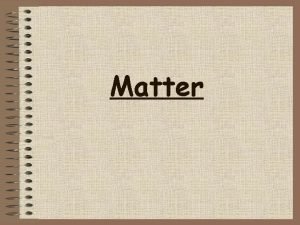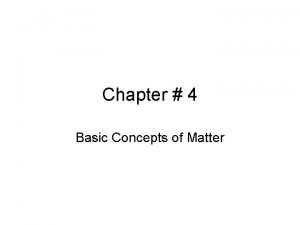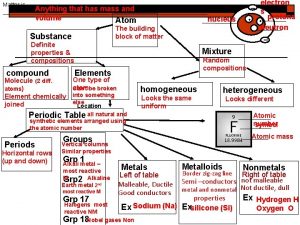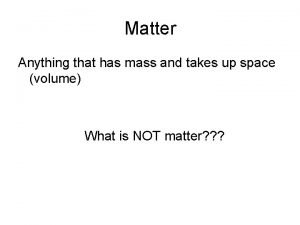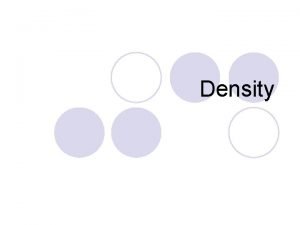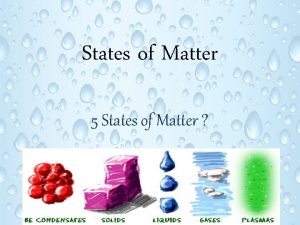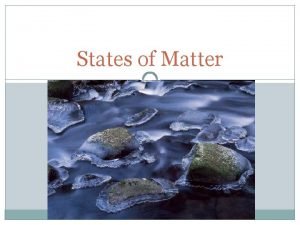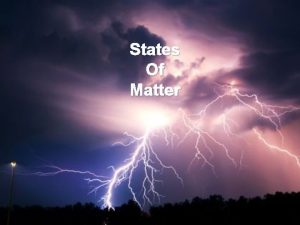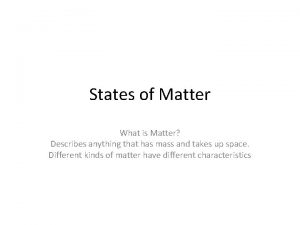Chapter 7 1 States of Matter Matter Anything














- Slides: 14

Chapter 7. 1 States of Matter

Matter Anything that has mass and volume The quantity of matter that a substance or object contains, the more matter the greater the mass Measured in grams (g) or kilograms (kg)

Volume Amount of space taken up by a substance Liquid measured in ml, L, or cm 3

States or Phases of Matter: �Solid – definite shape and volume �Liquid – definite volume but shape is determined by container �Gas – volume and shape are determined by their surroundings

The Particle Model of Matter 1. All matter is made up of very small particles. (atoms) 2. There are spaces between the particles 3. the particles that make up matter are always moving 4. the particles are attracted to each other, strength of attraction depends on type of particle

The Kinetic Molecular Theory Kinetic energy is the energy of motion Particles in solids, liquids and gasses are always in motion 1. All matter is made up of very small particles (atoms and molecules) 2. There is empty space between particles 3. Particles are constantly moving, colliding with each other and the walls of the container �Solids – particles only vibrate �Liquids – particles can slide past each other �Gasses – far apart and move around quickly 4. Energy makes particles move. More energy = faster movement


Thermal Expansion and Contraction To add energy we can add heat When we add heat the particles move faster The material expands and increases in volume = thermal expansion The opposite happens when a material cools = thermal contraction Each material expands or contracts at a unique rate Examples include: thermometer, car coolant containers, bridges

The Difference Between Heat and Temperature When two substances with different thermal energy come into contact, energy will flow from high to low thermal energy Heat = the energy transferred from one material to another Temperature = reading of a substance’s average kinetic energy


Changes of State �When temperature changes so can the state of the material: Melting = solid to a liquid Evaporation = liquid to a gas Condensation = gas to a liquid Solidification = liquid to a solid Sublimation = solid directly to a gas (dry ice) Deposition = gas directly to a solid (frost)


All substances have different specific temperatures at which they change state. Melting point = temp. when a solid goes to a liquid Boiling point = temp. when a liquid goes to a gas

HOMEWORK Textbook Questions P. 259 # 2, 3, 4, 5, 8, 9 and 10
 Chapter 12 states of matter study guide
Chapter 12 states of matter study guide Chapter 10 review states of matter section 4
Chapter 10 review states of matter section 4 Chapter 11 - states of matter: liquids and solids
Chapter 11 - states of matter: liquids and solids Anything that has mass and take up space
Anything that has mass and take up space Matter is anything that has
Matter is anything that has Anything that has mass and takes up space is
Anything that has mass and takes up space is Anything that has mass and occupies
Anything that has mass and occupies Matter is defined as anything that
Matter is defined as anything that Anything that has mass and volume
Anything that has mass and volume Anything that takes up space
Anything that takes up space No matter anything
No matter anything Matter is anything that occupies space
Matter is anything that occupies space Is matter anything that has mass
Is matter anything that has mass Matter anything that
Matter anything that Use of density
Use of density

